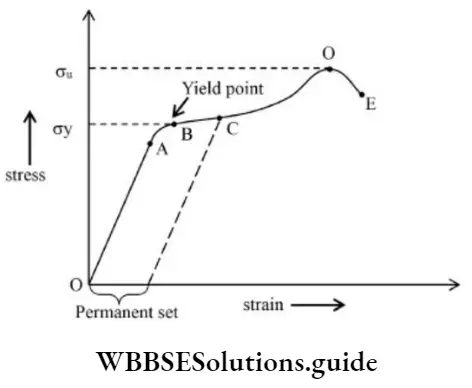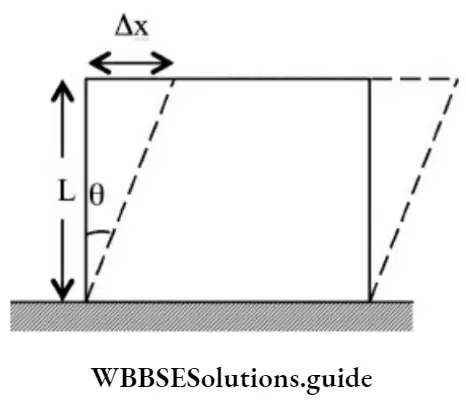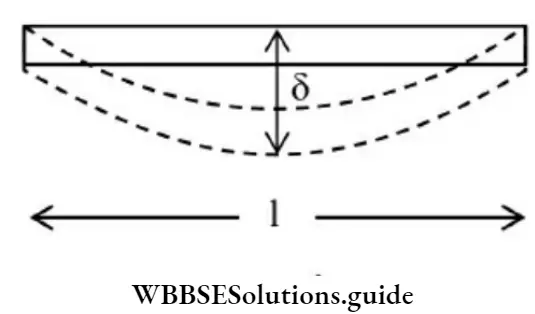Mechanical Properties Of Solids
Restoring force per unit area is known as stress.
Stress = \(\frac{\mathrm{F}}{\mathrm{A}}\)
Its S.I. unit is Nm 2 or Pascal (Pa)
Strain is defined as the change in the configuration of the body to the original configuration
Longitudinal strain = \(\frac{\text { Change in length }}{\text { original length }}=\frac{\Delta \ell}{\mathrm{L}}\)
Volume strain = \(\frac{\text { Change in volume }}{\text { original volume }}=\frac{\Delta \mathrm{V}}{\mathrm{V}}\)
Shear strain = the angle by which a line perpendicular to the fixed face turns.
Read And Learn More: NEET Physics Notes
Hooke’s Law
Within the elastic limit, stress is directly proportional to strain.
i.e., Stress-Strain
Stress = K Strain
Where,
K= \(\frac{\text { Stress }}{\text { Strain }}\) is called modulus of elasticity.
Stress-Strain Curve

NEET Physics Solids Chapter Notes with Important Formulas
Young’s Modulus
\(\mathrm{Y}=\frac{\text { Normal stress }}{\text { longitudinal strain }}=\frac{\mathrm{FL}}{\mathrm{A} \Delta I}\) If length of the wire is doubled, then strain = 1
∴ Y = Stress
Bulk Modulus
⇒ \(B=\frac{\text { Normal stress }}{\text { Volume strain }}=\frac{\frac{F}{A}}{-\frac{\Delta V}{V}}\)
⇒ \(\mathrm{B}=-\frac{\mathrm{PV}}{\Delta \mathrm{V}}\)
The reciprocal of Bulk modulus is called compressibility.
Compressibility, K = \(\frac{1}{B}\)
Best Short Notes for Mechanical Properties of Solids NEET
Modulus of rigidity (G):

⇒ \(\mathrm{G}=\frac{\text { Shearing stress }}{\text { Shearing strain }}\)
⇒ \(\mathrm{G}=\frac{\mathrm{FL}}{\mathrm{A} \Delta \mathrm{x}}=\frac{\mathrm{F}}{\mathrm{A} \tan \theta}=\frac{\mathrm{F}}{\mathrm{A} \theta}\)

Mechanical Properties of Solids NEET Important Questions
Poisson’s ratio:
⇒ \(\sigma=\frac{\text { Lateral strain }}{\text { Longitudinal strain }}\)
⇒ \(\sigma=-\frac{\frac{\Delta \mathrm{D}}{\mathrm{D}}}{\frac{\Delta \mathrm{L}}{\mathrm{L}}}\)
Where ‘D’ is diameter of the rod.
The maximum length of the wire that can be hung from the ceiling without breaking
Breaking stress =\(\frac{\text { Breaking force }}{\text { area of cross-section }}\)
⇒ \(\mathrm{S}=\frac{\mathrm{F}}{\mathrm{A}}-\frac{\mathrm{mg}}{\mathrm{A}}=\frac{\rho \vee \mathrm{g}}{\mathrm{A}}=\frac{\rho(\mathrm{A} l) \mathrm{g}}{\mathrm{A}}\)
⇒ \(\mathrm{S}-\rho l \mathrm{~g}\)
⇒ \(l=\frac{s}{\rho g}\)
NEET Physics Chapter Mechanical Properties of Solids
The maximum height of a mountain on earth is given by,
⇒ \(\mathrm{h}_{\max }=\frac{\mathrm{K}}{\rho \mathrm{g}}\)
Where K is the elastic limit of the earth-supporting material
The depression produced in a rectangular beam is given by,

⇒ \(\delta-\frac{\mathrm{w} l^3}{4 \mathrm{Ybd} \mathrm{d}^3}\)
Where l is the length of the beam, Y is Young’s modulus of the material of the beam, b is the breadth and d is the depth of the beam.
Work done in stretching a wire is given by,
⇒ \(\mathrm{W}=\frac{1}{2} \mathrm{~F} \Delta l\)
∴ The potential energy stored in a stretched wire is given by
⇒ \(\mathrm{U}=\frac{1}{2} \mathrm{~F} \Delta l\)
Where Δl is the increase in length.
∴ Potential energy per unit volume is given by,
Stress-Strain Curve and Elasticity NEET Notes
⇒ \(\mathrm{u}=\frac{\mathrm{U}}{\mathrm{v}}-\frac{1}{2} \frac{\mathrm{F} \Delta l}{\mathrm{~A} l}\)
⇒ \(\mathrm{u}=\frac{1}{2} \text { (stress) (strain) }\)
⇒ \(\mathrm{u}=\frac{1}{2} \times \mathrm{Y} \times(\text { strain })^2\)
